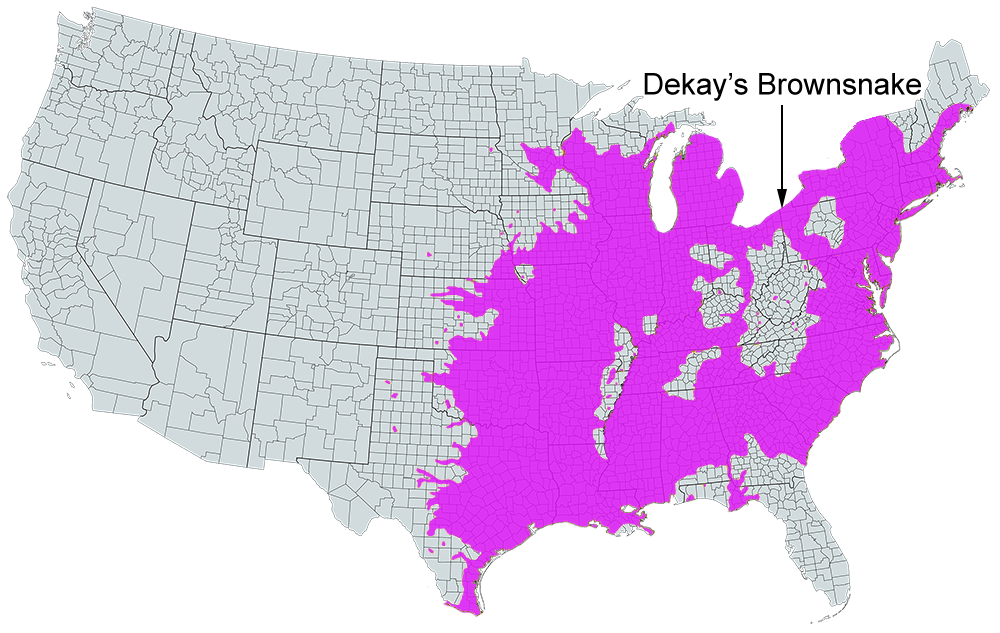Dekay's Brownsnake
Storeria dekayi
** Harmless **
Common Name: |
Dekay's Brownsnake |
Scientific Name: |
Storeria dekayi |
Etymology: |
|
Genus: |
Storeria is in honor of David Humphreys Storer, an 18th-century, zoologist from New England. |
Species: |
dekayi is in honor of James Ellsworth Dekay, a 19th-century naturalists. |
Vernacular Names: |
Brown grass snake, Dekay's snake, ground snake, house snake, little brown snake, rock snake, spotted adder, spotted brown snake. |
Average Length: |
9 - 13 in. (23 - 33 cm) |
Virginia Record Length: |
14.9 in. (37.9 cm) |
Record length: |
19.3 in. (49.2 cm) |
Systematics: Described originally as Coluber dekayi by John Edwards Holbrook in 1836, based on specimens from Massachusetts, New York, and Louisiana. The type locality was restricted to Massachusetts by Trapido (1944) and to Cambridge, Massachusetts, by Schmidt (1953). The genus Storeria was first used for this species by Baird and Girard (1853), and the combination Storeria dekayi has been used by all authors in the Virginia literature. Pyron et al. (2016, Zool. J. Linn. Soc. 177: 937–949) used high throughput molecular data to detect eight species-level clades within Storeria, but elected to recognize only four clades (three in the United States) that were corroborated by morphology. They concluded against the recognition of subspecies.
Description: A small, secretive snake reaching a maximum total length of 492 mm (19.3 inches) (Conant and Collins, 1991). In Virginia, maximum known snout-vent length (SVL) is 300 mm (11.8 inches) and maximum total length is 379 mm (14.9 inches). Tail length/total length in Virginia specimens was 15.0-30.5% (ave. = 21.9 ± 2.7, n = 132).
Scutellation: Ventrals 113-133 (ave. = 122.9 ± 4.1, n = 140); subcaudals 37-61 (ave. = 49.1 ± 5.5, n = 133); ventrals + subcaudals 158-186 (ave. = 171.9 ± 5.2, n = 133); dorsal scales keeled, scale rows 17 at midbody; anal plate divided; infralabials 7/7 (85.7%, n = 126) or other combinations of 6-8 (14.3%); supralabials 7/7 (90.6%, n = 128) or other combinations of 6-8 (9.4%); loreal scale absent; preoculars 1/1; postoculars 2/2; temporal scales usually 1+2/1+2 (72.0%, n = 132) or other combinations of 1-3 (28.0%).
Coloration and Pattern: Dorsum of body and tail light brown or gray to dark brown or nearly black, with a longitudinal series of small, paired black spots; area between spots is lighter than rest of body, forming a tan middorsal stripe in some specimens; a variable number of pairs of spots (2- 22) connected by a thin black crossbar; lateral scales tipped in black and white to form a checkerboard-like pattern in some specimens; venter cream to gray and usually patternless; 1 to several tiny black dots or areas of dark pigmentation lie at edges of ventral scales; dorsum of head light brown to dark brown (some are black in preservative) with a short, longitudinal black streak on temporal scales; supralabials have 1 to several dark vertical streaks or have variable amounts of dark pigmentation; chin and infralabials cream and patternless; head blunt.
Sexual Dimorphism: Sexual dimorphism occurs in body size and scutellation. Mature females averaged larger (232.3 ± 28.2 mm SVL, 175-296, n = 64) than mature males (199.6 ± 27.0 mm SVL, 150-300, n = 46), but the largest individual was a male (379 mm total length). Sexual dimorphism index was 0.16. Male offspring of a Powhatan County female averaged slightly smaller (61.7 mm SVL) than the female offspring (64.3 mm SVL) (Mitchell, 1976b). Tail length/total length in females (15.0-24.9%, ave. = 20.2 ± 1.8, n = 76) was slightly lower than the values for males (19.6-30.5%, ave. = 24.3 ± 1.8, n = 56).
Females had a higher average number of ventral scales (125.1 ± 3.6, 113-133, n = 79) than males (119.9 ± 2.5, 114-125, n = 61), but fewer average number of subcaudals (45.8 ± 4.4, 37-61, n = 76) than males (53.5 ± 3.4, 47-61, n = 57). Average counts of ventrals + subcaudals (males 173.3 ± 4.4, 164-184, n = 57; females 170.8 ± 5.5,158-186, n = 76) were similar between sexes.
Juveniles: Juveniles are uniformly dark brown to black dorsally, with a narrow cream to yellow collar on the neck. This pattern changes in the first year of life to that seen in adults. At birth, S. dekayi was 57-77 mm SVL (ave. = 68.9 ± 4.5, n = 47) and 80-106 mm total length (ave. = 91.3 ± 6.0, n = 46), and weighed 0.21-0.33 g (ave. = 0.28 ± 0.05, based on means of 4 litters).
Confusing Species: This species may be confused with several other small Virginia snakes. Virginia valeriae may have small black spots on the dorsum but has smooth scales. Haldea striatula has keeled scales and lacks the dorsal spots. Both of these species have more-pointed heads than S. dekayi. Diadophis punctatus adults are uniformly gray to nearly black with a conspicuous collar; adults and juveniles have smooth scales. Tantilla coronata is uniformly brown with a black head and collar on the neck. Thamnophis sirtalis has a distinct middorsal stripe; a dorsolateral checkerboard pattern, the spots of which occur on more than 1 scale; and a longer head. The congeneric Storeria occipitomaculata has a reddish venter and 3 light spots across the neck in adults and juveniles.
Geographic Variation: The average number of ventral scales was similar among physiographic regions in Virginia, ranging from 121.9 ± 4.0 (116-130, n = 34) in the northern Piedmont to 124.0 ± 3.5 (119-131, n = 18) in the southern Coastal Plain. The average number of subcaudals in the northern Piedmont (45.8 ± 5.4, 40-61, n = 34) was slightly less than elsewhere in the state (averages varied from 49.5 ± 4.5 to 50.6 ± 5.7). Consequently, counts of ventrals + subcaudals in northern Piedmont populations (167.7 ± 5.5, 158-186, n = 34) were lower than in other parts of the state (averages varied from 172.5 ± 4.2 to 174.4 ± 3.5). The low scale counts were most characteristic of S. dekayi from Fairfax County. Trapido (1944) showed that there were few differences in scutellation and morphometries in the range of S. dekayi.
Biology: Dekay's Brownsnakes are terrestrial, secretive, and seldom found in the open. They are nocturnal, but are most often found under surface objects such as boards, trash of all sorts, logs, and rocks. Their microhabitat may be described as the soil-humus layer. Habitats include hardwood forests, mixed hardwood-pine forests, pine woods, grasslands, early successional stages of abandoned agricultural land, woodlots, and urban areas. These snakes are frequently found under debris and in gardens in yards. More have been found in human-disturbed areas than in natural habitats. They are active primarily between 13 March and 20 October (museum records), although this snake has been found in every month of the year (two have been found in February). Noble and Clausen (1936) examined the aggregation behavior of S. dekayi and found that it occurs at all times of the year, but especially during winter hibernation. Hibernation sites include ant mounds and abandoned rodent burrows. Aggregations of more than two individuals have not been reported from Virginia.
Slugs and earthworms are the primary prey of S. dekayi in Virginia. Wright and Wright (1957) noted that snails, insects, small treefrogs, and fish were eaten by this snake. Known predators of S. dekayi in Virginia are free-ranging domestic cats (Mitchell and Beck, 1992) and Northern Cottonmouths (Agkistrodon piscivorus). Ernst and Barbour (1989b) listed Northern Black Racers (Coluber constrictor), kingsnakes and milk snakes (Lampropeltis spp.), Virginia rails (Rallus limicola), loggerhead shrikes (Lanius ludovicianus), robins (Turdus migratorius), redshouldered hawks (Buteo lineatus), raccoons (Procyon lotor), striped skunks (Mephitis mephitis), weasels (Mustek spp.), and opossums (Didelphis virginiana). Linzey and Clifford (1981) mentioned that toads (Anaxyrus spp.) eat the young, but provided no observations.
Storeria dekayi is viviparous. In Virginia, the smallest mature male I measured was 150 mm SVL and the smallest female was 175 mm SVL. Mating has not been observed in Virginia, but Ernst and Barbour (1989b) noted that it occurred from late March through May. They also stated that the gestation period was 105-113 days. Courtship and mating was described by Nobel (1937, repeated in Ernst and Barbour, 1989b). Virginia females bore litters of 3-26 young (ave. = 10.8 ± 4.3, n = 26). Birth dates for nine litters were 22 July to 30 August, about evenly divided between the two months. Fitch (1970) and Ernst and Barbour (1989b) reported birth dates of 6 July-14 September, and litter sizes of 3-41 from throughout the range of this species. Dekay's Brownsnakes appear to be more abundant in eastern Virginia than in the mountains. Clifford (1976) recorded 5 S. dekayi out of 278 snakes over a 4-year period in Amelia County. Martin (1976) found 1 in a total sample of 545 snakes observed on the Blue Ridge Parkway and Skyline Drive in a 3-year period. Of the 885 snakes examined by Uhler et al. (1939) from the George Washington National Forest, none was a S. dekayi. The population ecology of this snake has been little studied. Nobel and Clausen (1936) determined that snakes in a New York population moved up to 402.5 m and grew 0-146 mm during a single season. A total of 603 individuals were once found in a 2-hectare field in Pennsylvania (Ernst and Barbour, 1989b).
Remarks: Other common names in Virginia are DeKay's snake (Hay, 1902; Carroll, 1950) and ground snake (Dunn, 1936).
Conservation and Management: This snake used to be commonly found in cities around abandoned lots and trash piles. The cleanup of these areas and the use of pesticides throughout Virginia (killing this snake's food sources) are thought to have reduced many populations. Recognition as a species of special concern is not justified, but its apparent decline in numbers warrants continued vigil. Management options include the creation of forest litter habitat in city parks and urban areas, and the control of predators, such as domestic cats.
References for Life History
Photos:
*Click on a thumbnail for a larger version.
Verified County/City Occurrence in Virginia
Accomack
Albemarle
Alleghany
Amelia
Amherst
Appomattox
Arlington
Bath
Bedford
Botetourt
Brunswick
Buckingham
Campbell
Caroline
Charles City
Charlotte
Chesterfield
Cumberland
Dinwiddie
Fairfax
Fauquier
Fluvanna
Franklin
Gloucester
Goochland
Greene
Halifax
Hanover
Henrico
Henry
Highland
Isle of Wight
James City
King and Queen
King George
King William
Lancaster
Loudoun
Louisa
Lunenburg
Mathews
Mecklenburg
Nelson
New Kent
Northampton
Northumberland
Nottoway
Orange
Patrick
Pittsylvania
Powhatan
Prince Edward
Prince George
Prince William
Pulaski
Richmond
Rockbridge
Scott
Southampton
Spotsylvania
Stafford
Surry
Sussex
Westmoreland
York
CITIES
Alexandria
Chesapeake
Emporia
Fairfax
Falls Church
Fredericksburg
Hampton
Lynchburg
Martinsville
Newport News
Poquoson
Richmond
Roanoke
Suffolk
Virginia Beach
Williamsburg
Verified in 65 counties and 16 cities.
U.S. Range



venter_small.jpg)
_small.jpg)











